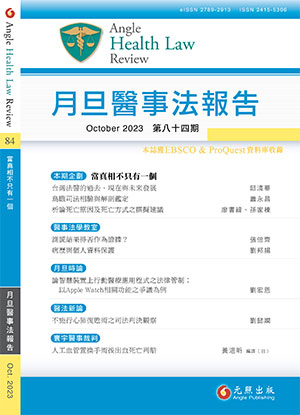論智慧裝置上行動醫療應用程式之法律管制︰以 Apple Watch相關功能之爭議為例【月旦時論】 試閱
The Legal Regulation of Mobile Medical Apps on Smart Devices: Taking the Controversy of Related Functions of Apple Watch as an Example
智慧手機、智慧手錶等智慧裝置,已經成為現代人幾乎每日難以離身的必備裝置。而各式各樣行動應用程式中,與醫療或健康相關的程式越來越多。本文借用Apple Watch相關功能的例子,來說明行動醫療應用程式在管理與規範上的可能爭議。究竟Apple Watch的心電圖功能及血氧濃度測量功能,是否應該定位為醫療器材?在醫療應用程式相關產業與市場規模居於全球領先地位、也是Apple Watch品牌所來自的美國,是否以之為醫療器材來加以管理?其管理方式如何?究竟為什麼Apple Watch的心電圖功能於2020年時在臺灣仍然無法開放使用,但血氧濃度測量功能卻可以開放,而且食藥署於媒體上的公開說法前後相互矛盾,可能顯示了什麼問題?而直接以一般民眾或消費者為使用與宣傳對象的相關應用程式,其訴諸醫療健康功能的行銷廣告在美國如何受管制?由於過去研究指出臺灣相關規範指引深受美國影響,本文將以美國管制架構及方式為比較研究對象,針對上述議題提出初步探討與分析。
Smart devices with internet connectivity have become essential tools that people almost never leave home without. In Taiwan, among all the mobile apps, the number of mobile health app users has increased the most, mainly because of the convenience of the apps, the easy accessibility and intuitive operation, and the autonomy of users to control their own medical and health conditions. However, the widespread uses of the apps may lead to many controversial issues, such as: Are they medical devices and should they be pre-approved? Are they likely to pose health risks to users? This paper aims to examine the regulatory system and experience and their problems in the U.S. and Taiwan on these issues, and it takes Apple Watch as an example for discussion.
132-154






